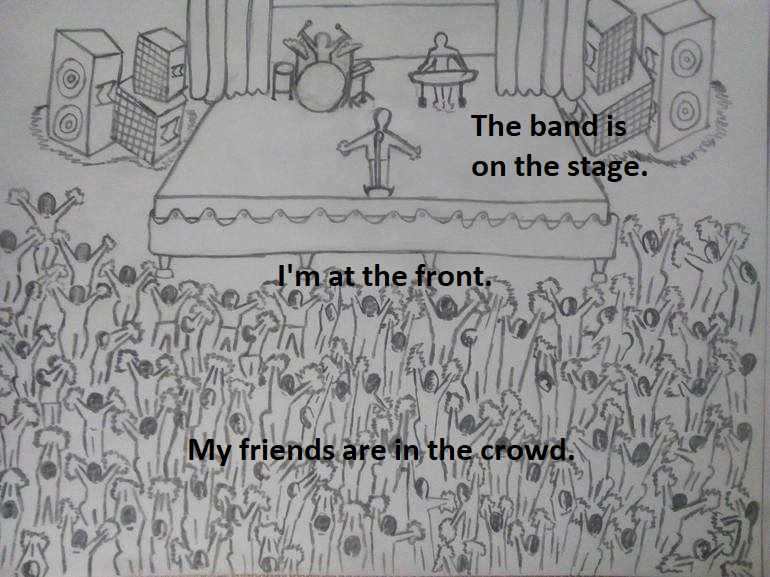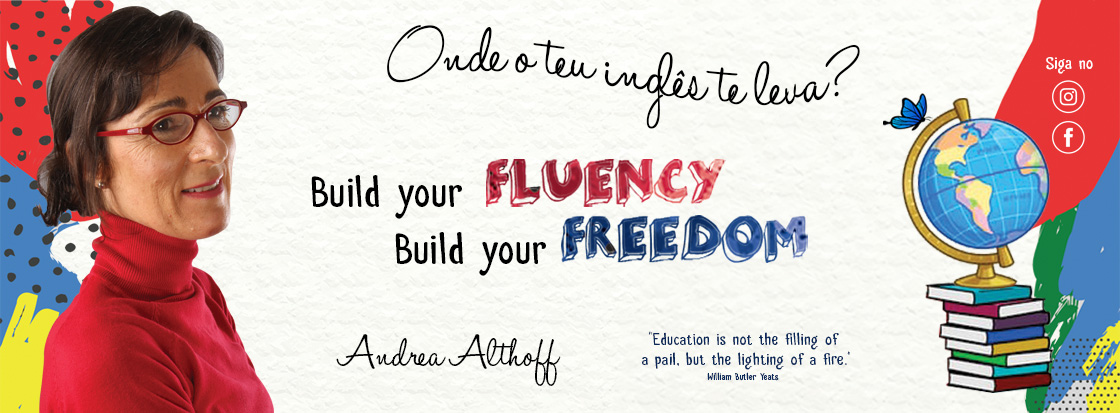Learn the differences between ‘at,’ ‘in,’ and ‘on,’ as prepositions of place with this awesome video! Take notes, use the subtitles and play the video slower than its speed if you need.
Good, right?
So let’s look again at the differences between ‘at,’ ‘in,’ and ‘on’ for locations with a different lesson.
At can be used to talk about a specific location.
- I’m at work.
- He’s at the shops.
On is frequently used in relation to a surface.
- I’m sitting on a chair.
- The pen is on the table.
- You can hang the picture on the wall.
In often talks about a three-dimensional space – often with four walls. It’s similar to ‘inside’.
- The bed is in the bedroom.
- The flowers look great in that vase (or in the garden).
- David is playing in the forest.
Remember! Think of a music concert:
I’m at the front. The band is on the stage. And my friends are in the crowd.

EXPLAINED IN MORE DETAIL
Now, we will look at the different ways to use the prepositions ‘in,’ ‘on,’ and ‘at,’ more examples, meanings, and exceptions to the rules. First, test your knowledge of the vocabulary with the quiz.
At
‘At’ is often used for public places. For example, you can say ‘at the cinema’ or ‘at the mall.’
‘At’ in this case can mean that you’re inside the place, or just near it.
Often, in these cases, it’s possible to use ‘in’ or ‘at’ with no difference in meaning. You can say ‘I’m in the supermarket’ or ‘I’m at the supermarket’; both are correct and commonly used.
There might be a small difference. If you want to emphasize that you’re inside a building, then use ‘in.’ If you’re outdoors, then use ‘at.’
‘At’ can mean ‘next to’. Let’s see a couple of examples:
- They sat at the table and discussed what to do next.
- Someone’s at the door. Can you answer it?
- I was waiting at the bus stop for half an hour.
Use ‘at’ with events or the building where an event or activity takes place.
- at a party
- at a meeting
- at a concert
- at the cinema
- at the library
- at the airport
Use ‘at’ with people’s homes or offices. You can say:
- I was at Tim’s house yesterday.
- We’ll be at Sasha’s place for dinner tonight.
Use ‘at’ for a temporary stop during a journey:
- We stopped at a nice village.
- The train to Manchester stops at Birmingham.
There are a few fixed phrases with ‘at’ that it’s better just to memorize. The most important ones are:
- at home
- at work
- at school
- at college
- at university
- at church
- at reception
Note that you never use an article, like ‘a’ or ‘the,’ in the phrases ‘at home’ and ‘at work,’ and you generally don’t use an article when you say ‘at school,’ ‘at college’ or ‘at university.’
Use ‘at’ to talk about position or time with phrases like:
- at the end of
- at the beginning of
- at the top of
- at the bottom of
For example: ‘Please read and follow the instructions at the top of the page.’
Finally, use ‘at’ with an exact address, when we know the name and number of the street, for example: ‘I live at 13 Crinklewell Crescent.’
On
Use ‘on’ when something is on a surface:
- on the floor
- on the shelf
- on the kitchen counter
- on the bed
- on my desk
- on a chair
- on the ceiling
You can use ‘on’ with all kinds of surfaces – not just horizontal ones:
- She has a small spot on her nose.
- There is a photograph on the wall.
- He spilled coffee on his shirt.
Use ‘on’ with print media:
- on page one
- on the menu
- on the map
You use ‘on’ with geographical features, like islands and beaches.
- There’s a pretty church on that island.
For canal and other bodies of water like rivers and lakes, we think of them as surfaces.
- We had a lovely gondola ride on the Grand Canal.
But ‘on’ and ‘in’ are both possible with mountains. We say that someone or something is on a mountain If we are talking about a single mountain.
We say that someone or something is in the mountains (in the plural) when we are talking about a mountain range.
- They went skiing on Mont Blanc.
- They went skiing in the Alps.
Use ‘on’ with transport in which you sit on top of: bicycles, motorbikes, and horses. You also use ‘on’ with public transport and boats. So, you say:
- on the plane
- on the bus
- on the boat
Here’s one more example: ‘He’s sitting on the train and talking on the phone.’
Use ‘on’ to talk about using devices:
- on the phone
- on the internet
- on the radio
- on TV
Use ‘on’ with floors. You say:
- on the ground floor (British English = first floor, American English)
- on the second floor
- on the fifth floor
Use ‘on’ is when something is ‘attached’ to something else:
- She is wearing a ring is on her finger.
- There are three apples on the tree, etc.
Use ‘on’ for a town close to a coast, river, or the coast, and for roads and streets.
- Florianópolis is a town on the south coast of Brazil.
- Blumenau is on the river Itajaí Açú.
Use ‘on’ for talking about places along a road when we do not know the number of the street:
- I live on México Street.
Finally, ‘on’ a farm, ‘on’ the left/ ‘on’ the right, are standard expressions.
In
The most common use of the ‘in’ preposition is for cities and countries.
- I live in Brazil.
- She lives in Paris.
Use ‘in’ for rooms and indoor spaces:
- in the living room
- in the apartment
- in my bedroom
Also, use ‘in’ for containers and enclosed spaces:
- in the bowl
- in the box
- in your pocket
Also, use ‘in’ plus ‘north’, ‘south’, ‘east’ or ‘west’:
- She lives in the south of Spain.
- Thailand is in south east Asia.
Use ‘in’ with establishments and businesses:
- in the shop
- in a restaurant
- in the supermarket
As you saw before, sometimes, ‘at’ is also possible here, with a similar meaning.
You also say ‘in the centre’ or ‘in the middle’.
Use ‘in’ to talk about media:
- in a picture
- in the photograph
- in the film
- in the newspaper
Use ‘in’ with cars and taxis. With most other transport, use ‘on.’
You also use ‘in’ to mean ‘surrounded by a material’:
- in the air
- in the water
- in the sea
- in the sky
- in a thick sauce
Use ‘in’ to talk about many outdoor spaces. You can use ‘in’ for smaller, enclosed spaces. For example:
- in the park
- in a field
- in the garden
You can also use ‘in’ for larger, more open spaces:
- in the countryside
- in the sky
- in the world
Use ‘in’ to talk about things which are enclosed by part of your body. You can hold something in your hand. If you eat too much sugar, you’ll get toothache – a pain in your tooth.
- He felt a sudden pain in his stomach.
There are some fixed phrases with ‘in’ that don’t follow a clear pattern. Notice that we do not use the word “the”. The most useful are:
- in bed
- in hospital
- in prison
If you are talking about ‘armchair,’ you say, ‘we sit in an armchair,’ but if it is a regular chair, you say ‘we sit on a chair.’
There is no rule. We must learn these fixed expressions.
Finally, use ‘in’ to talk about things which are in a line. For example:
- We sat on the floor in a row.
- He arranged his tools in a neat line.
This also works if you arrange things into a shape. For example: ‘We set out the chairs in a circle.’
Wow! That is a comprehensive and highly necessary lesson! 😉
